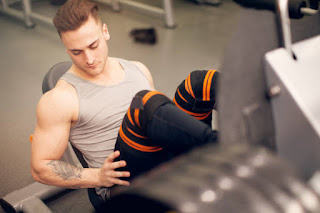What is the Purpose of Wrist Wraps?
Hey, fellow fitness enthusiasts! Today, we're delving into the world of wrist straps—the unsung heroes of the weightlifting realm. If you've ever wondered about the purpose, pros and cons, and the differences between wrist wraps and lifting straps, you're in the right place. Let's wrap our minds around wrist straps and uncover their potential for elevating your lifting game!
The Purpose of Wrist Straps: Strengthening Your Grip
Wrist straps, also known as wrist wraps or lifting straps, are essential accessories designed to provide support and stability to your wrists during weightlifting exercises. Their primary purpose is to enhance grip strength and reduce the risk of wrist injuries when handling heavy weights. By securing your wrists in a proper position, wrist straps enable you to focus on the targeted muscle groups without worrying about your grip giving out.
Pros of Wrist Wraps: The Perks of Support
Grip Strength Amplification: Wrist wraps help you maintain a strong and consistent grip on the bar or dumbbells, even when fatigue sets in. This allows you to perform additional repetitions and push your limits during lifting sessions.
Wrist Stability: By limiting excessive movement in your wrists, these straps provide much-needed stability during heavy compound exercises like deadlifts and bench presses, minimizing the risk of sprains and strains.
Injury Prevention: Wrist wraps can act as a preventive measure against chronic wrist pain and overuse injuries, particularly for those with pre-existing wrist issues.
Focus on Target Muscles: A secure grip frees up mental bandwidth, enabling you to concentrate solely on engaging the targeted muscle groups during lifts.
Confidence Booster: Knowing that your wrists are supported gives you the confidence to tackle more challenging lifts and break personal records.
Cons of Wrist Wraps: The Caveats to Consider
Overreliance Concerns: Regular use of wrist straps may lead to a dependency on them, potentially hindering natural grip strength development in the long run.
Lack of Forearm Activation: With wrist straps, the forearm muscles may not be fully engaged during lifts, which could impact overall forearm development.
Improper Form Concealment: Relying solely on wrist wraps without addressing underlying form issues may mask weaknesses in your lifting technique, potentially leading to injuries.
Limited Application: Wrist wraps are most beneficial for exercises that involve heavy weights and wrist strain, but they may not be necessary for lighter lifts.
Wrist Wraps vs. Lifting Straps: The Distinctions
It's common for people to use the terms "wrist wraps" and "lifting straps" interchangeably, but they serve different purposes:
Wrist Wraps:
As mentioned earlier, wrist wraps provide support and stability to your wrists during lifting. They are long, elastic or cloth-based bands that are wrapped tightly around the wrists before beginning exercises like bench presses, overhead presses, and push-ups.
Lifting Straps:
Lifting straps, on the other hand, are designed to enhance grip on the barbell or dumbbells when performing pulling exercises like deadlifts, rows, and pull-ups. They are usually made of sturdy materials, such as nylon or leather, and loop around the wrist and bar to create a secure connection.
To Wrap or Not to Wrap: Using Wrist Straps for Different Lifts
Now that we understand the purpose, pros, and cons of wrist straps, the big question remains—should you use them for deadlifts, benching, or other lifts?
Deadlifts:
Deadlifts are a common exercise where lifting straps can be incredibly useful. They allow you to maintain a firm grip on the bar, especially during heavy sets when your grip strength might falter. By using straps, you can concentrate on engaging your back and hips without worrying about the bar slipping from your hands.
Bench Press:
Unlike deadlifts, the bench press doesn't typically require wrist straps, as your hands are secured on the barbell throughout the lift. However, some individuals with wrist discomfort or mobility issues might find wrist wraps helpful to provide extra support during benching.
Other Lifts:
For exercises that involve pushing movements, such as overhead presses and push-ups, wrist wraps can be advantageous to maintain wrist stability and reduce discomfort. However, for pulling exercises like rows, pull-ups, and lit pulldowns, lifting straps are the more suitable option to improve grip and focus on targeting back muscles.
Wrap it Up: Final Thoughts on Wrist Straps
Wrist straps, whether in the form of wrist wraps or lifting straps, can be valuable tools in your weightlifting journey. They offer enhanced grip strength, improved wrist stability, and injury prevention benefits. However, it's crucial to strike a balance and avoid becoming overly reliant on these accessories.
For compound lifts like deadlifts, where grip strength is often the limiting factor, lifting straps can be a game-changer, allowing you to lift heavier and challenge yourself. On the other hand, wrist wraps are more appropriate for exercises that put significant strain on your wrists, such as heavy bench presses or overhead presses.
Ultimately, the decision to use wrist straps boils down to your personal fitness goals and individual needs. For beginner lifters, it's advisable to focus on building natural grip strength initially, incorporating wrist straps only when necessary for particularly challenging lifts. On the contrary, experienced lifters may choose to integrate wrist straps strategically into their training routines to optimize performance and mitigate the risk of wrist injuries.
In conclusion, wrist straps can be a valuable ally in your pursuit of strength and gains, but like any tool, they should be used judiciously and in conjunction with proper lifting techniques. Now, armed with knowledge about wrist straps, you're ready to tackle the barbell and elevate your lifting prowess to new heights! Happy lifting!
.jpg)
.jpg)


Comments
Post a Comment